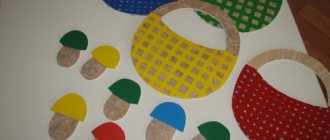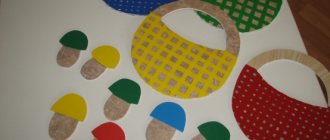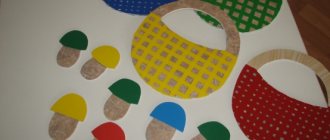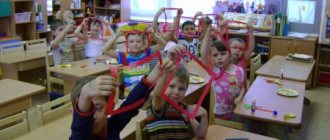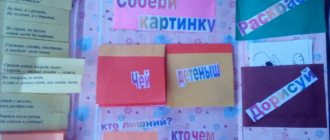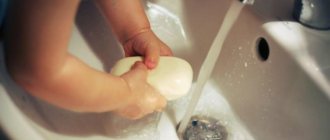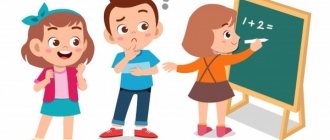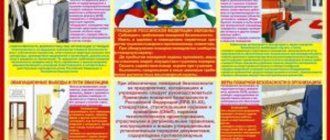Teaching numeracy, systematized and methodologically justified by the Federal State Educational Standard (FSES), is included in the system of work with preschoolers in kindergarten. However, the age characteristics of children require particularly careful preparation of visual aids. The most important role is given to the counting material. We will look at the types of counting material used in mathematics classes in different age groups, and give advice on how to make it yourself as a demonstration and handout.
- 2 Features of demonstration and handout material for different age groups
2.1 Types of handouts2.1.1 Photo gallery: examples of counting handouts
- 3.1 How to make didactic materials for the preparatory group with your own hands
3.1.1 Photo gallery: example of a homemade laptop
- 4.1 Photo gallery: examples of individual cards and a picture for a mobile folder
- 5.1 Photo gallery: individual cards for the senior group
The validity of using visual counting material in kindergarten
In a preschool educational institution, children begin to master counting at the age of three, and this is their main mathematical activity. Learning takes place with the indispensable support of visual aids, since abstract logical operations performed during counting (merging and dividing sets, comparing quantities and numbers, comparing sets) are difficult for children to understand and require “objectification.” Visual counting material is a comprehensive didactic tool aimed at developing basic ideas about counting as part of targeted learning.
Famous teacher K.D. Ushinsky said: “Children’s nature itself requires visual learning.”
Such benefits are very diverse, and their application in each case depends on:
- specific content of educational material (for example, teach children of the second youngest group to distinguish between the concepts of many and few);
- methods used (more precisely, certain gaming techniques, for example, illustrations for a fairy tale in which characters learn to count);
- the age of the children (if in the second younger group there may be cards with pictures of the same animal, then in the older group the pictures depict different animals, that is, the essence of the phenomenon being described becomes more complex).
Counting in kindergarten is mastered along with other didactic skills and concepts, for example, learning about colors: distribute the mushrooms into baskets of the corresponding colors and say which one has more/fewer of them
Visual material must meet the following requirements:
- scientific (correspond to scientific data on counting);
- pedagogical (carry an educational, developmental, educational load);
- sanitary and hygienic (do not contain harmful substances, do not cause eye strain;
- aesthetic (beautiful design, bright and clear images)
A few helpful tricks
You probably understand perfectly well that information is best absorbed when the maximum number of senses is involved. So learning to count will be much easier and more effective if your child learns to count not only with his eyes.
To activate unused senses, you can resort to the following tricks:
- Let the baby move the counting items himself
- Let your baby always say the numbers out loud at each counting step.
- Make cards, tablets and cubes for teaching counting in different colors, shapes, sizes and weights (you can increase the proportions of objects along with increasing numbers)
- Involve associative thinking: ask your child to compare counting objects with fairy-tale characters, cartoon characters, favorite movie characters, etc.
- Involve the child’s taste and smell in the process: lay out numbers with vegetables and fruits, count flowers and enjoy their aroma, count cookies and candies and eat them, etc.
Know that teaching a child to count is not as difficult as it might seem at first glance. The main thing here is to take your time, remain calm and patient, take into account the individual characteristics of the baby, not be afraid of failures and believe in haste.
In the third lesson we will talk about the teaching methods of Doman and Zaitsev, talk about mental counting, counting on fingers and working with counting material, and also point out the main advantages and disadvantages of these methods.
Features of demonstration and handout material for different age groups
Calculating material in mathematics, like other visual aids, can be of two types:
- large, that is, demonstration, which is used by the teacher to explain and show how to operate with it (magnetic boards, posters, paintings, etc.);
- small, that is, handout (cards, laptops, etc.), using which all children perform certain tasks at the same time, which allows organizing independent activities of children to develop the necessary mathematical skills and abilities.
Visual mathematical material differs in the type of counting activity, which is a priority for a specific age category.
- Second junior group. To form the concept of singularity and multiplicity, you can use, for example, puzzle pictures, cubes in which numbers are surrounded by elements with the same number of fruits (vegetables, animals, etc.) or pictures with dots that need to be correlated with the number. By the way, the same material with dots is still used, only there are more numbers.
- Middle group. Children must be able to give an accurate assessment of a set of objects, in this case counting to 5. For this, pictures depicting objects and numbers corresponding to their quantity are actively used, as well as a combination of a toy and a three-dimensional number. For example, to recognize the graphic image of a number, the task could be as follows: help the bunny find the number 3. Place a moth on a flower with five petals.
- Senior group. Kids count to 10 and can add or subtract one at a time. For clarity, they use, for example, the game of dominoes, matching a number with a picture with the same number of objects.
- Preparatory group. Children can compare numbers “more and less”, and make up given numbers from two smaller ones - 5 from 2 and 3, for example. The demonstration material becomes more complex. These could be tasks for comparing the number of objects in pictures, composing a whole image after sequentially folding numbered cut parts, etc.
Counting sticks are a universal visual aid: they allow you to demonstrate and practice all types of counting activities.
Thus, the first manuals are aimed at ensuring that children learn to correlate the visual image of a number and the number of objects it denotes. In the middle group, this work is no longer on “recognizing” the image of a number, but on quantitative counting up to 5. In the older group, children learn to perform basic addition and subtraction operations, and in the preparatory task materials are comparative in nature, since children already know how to correlate quantities , indicated by numbers.
At any stage of training, it is necessary to think over a way to get acquainted with the graphic image of a number, for example, in the form of creating an application
Types of handouts
As already mentioned, manuals can be demonstration or handout. And there are also those that can be used in both cases (for example, Dienesh blocks). The teacher chooses the types of handouts depending on the age of the children. So, already in the first junior group, children get acquainted with cubes and counting sticks. True, so far the assessment level is “a lot or a little.” Typically, the gradation of the use of types of handouts depends on the age of the children: the younger, the more toys, and the older, the more drawings and diagrams. In general, the following counting aids are actively used in kindergarten:
- Cuisenaire sticks (multi-colored parallelepipeds of different sizes made of wood or plastic are used mainly in the second junior and middle groups, when the concept of quantity is introduced);
- Dienesh blocks (a set of geometric shapes of different sizes, which can be used by analogy with Cuisenaire sticks, as well as to introduce rectangles, triangles, circles, squares);
- cubes (in the younger group they practice the concepts of “many and few”);
- pyramids (as a budget, more affordable version of Cuisenaire sticks and Dienesh blocks);
- beads, buttons (in junior and middle groups);
- pictures, puzzle pictures, cards (for all ages);
- fan with numbers (for senior and preparatory groups, in which the children already clearly associate a number with its graphic image);
- lapbooks, tasks in which can combine all of the above manuals, etc.
Please note that there is no clear age division in the use of counting materials, since their use must be justified from the point of view of the educational goal. And yet, in the senior and preparatory groups, the emphasis is on cards, so that children get used to working with clarity “like at school.”
Photo gallery: examples of counting handouts
The capabilities of counting cubes allow them to be used up to the preparatory group
To master the skill of counting to 5, it is convenient to use special pyramids
A fan with numbers is a tool for school, but can also be used in kindergarten
Using blocks you can practice mastering basic geometric shapes and counting objects in groups
You can learn to count on sticks completely unnoticed: for example, by laying out figures from them
Psychological and pedagogical foundations of the development of children of middle preschool age
Middle age is the most important period in the development of a preschooler.
The physical capabilities of children have increased: their movements have become much more confident and varied. In the middle group, it is especially important to establish a reasonable motor mode. The middle preschooler needs meaningful contacts with peers. Children communicate about toys, joint games, and common affairs. Their verbal contacts become longer and more active. Children easily unite into small subgroups based on common interests and mutual liking.
The main activity of middle-aged children is play, and productive activities also appear: drawing, modeling, designing. In story games, children easily use various substitute objects (for example, a cube as soap). This develops the child's fantasy and imagination.
In play, the child discovers for the first time the relationships that exist between people; the child himself can fulfill one or another role. The child’s mental activity develops in play. Within the play activity, educational activity also begins to take shape, which later becomes the leading activity. A preschooler begins to learn by playing - he treats learning as a kind of role-playing game with certain rules.
In the middle group, preference is given to the play structure of the entire lifestyle of children. Children participate in a variety of games throughout the day.
All types of classes either take the form of a game or contain game situations and actions. New features appear in the communication of middle preschoolers with the teacher. Children strive for cognitive, intellectual communication with adults. This is manifested in numerous questions from children to the teacher: “Why?”, “Why?”, “For what?”.
Children’s ability to establish the simplest connections and relationships between objects awakens interest in the world around them. The teacher’s friendly, interested attitude towards children’s questions and problems, the willingness to discuss them “as equals” with children helps, on the one hand, to support and direct children’s cognitive activity in the right direction, on the other hand, it strengthens the trust of preschoolers in adults. This promotes a sense of respect for elders.
A preschooler in his fifth year of life is highly active. This creates new opportunities for the development of independence in all areas of his life. There is an awakening of interest in the rules of behavior. The main thing is to anticipate the actions of children and orient them in advance to the correct behavior.
Middle-aged children are highly emotional and express their feelings clearly and directly. The teacher awakens the emotional responsiveness of children, directs it towards sympathy with peers and basic mutual assistance.
Children's aesthetic senses develop. They notice the beauty of nature, the sound of music. An adult helps the child with this. An attentive, caring attitude towards children, the ability to support their cognitive activity and develop independence, and the organization of various activities form the basis for the proper upbringing and full development of children in the middle group of kindergarten.
The teacher gradually develops the gaming experience of each child, helps to discover new opportunities for playful reflection of the world, awakens interest in creative manifestations in play and playful communication with peers.
A preschool child does not have sufficient abilities to connect temporal, spatial and causal sequences with each other and include them in a broader system of relationships. He reflects reality at the level of ideas, and these connections are acquired by him as a result of direct perception of things and activities with them.
When classifying, objects or phenomena are combined based on common characteristics into a class or group, for example: all people who know how to drive a car, etc. Classification forces children to think about the underlying similarities and differences between different things as they need to make inferences about them.
Lapbook for FEMP “Quantity and counting”
A laptop is a folder that contains material on a specific topic. The organization of the material in such a manual is that the teacher arranges the visualization in the form of mini-books, accordion layouts, gift boxes, windows or pockets, etc. In addition, the lapbook necessarily includes tasks of a creative nature.
Lapbooks are also used to form elementary mathematical concepts (EMPs) - the fruits of the teacher’s creative approach to the implementation of learning tasks. Benefits are calculated for a specific stage of training. Since lapbooks were originally made by parents to teach their child, these manuals, put on a “methodological stream,” are now used for individual work, as well as for working in pairs or threes.
How to make didactic materials for a preparatory group with your own hands
First, you need to determine the goals of the Quantity and Counting lapbook.
- Strengthen the ability to count to 10.
- Practice ordinal and quantitative counting.
- Practice the skill of comparing numbers with the number of objects.
- Learn to write numbers.
- Develop the ability to add, subtract and compare numbers within 10.
- Develop active vocabulary, logic, memory and thinking.
- Work on the ability to independently solve assigned problems.
- Cultivate responsiveness, self-confidence and self-confidence.
After the organizational stage, you can proceed directly to production. This process begins with the preparation of the necessary materials. Moreover, methodological questions are developed first, and only then a suitable design is selected for them.
Typically a lapbook includes:
- pictures with numbers for visual perception of their graphic image;
- cards with numbers and objects (either separately or 2 in 1);
- puzzles (cut numbers or pictures, each piece of which shows a number, etc.);
- pictures of fairy tales with numbers in their titles;
- coloring books;
- copybook;
- riddles, counting rhymes, etc.
It is most convenient to organize materials into files, which, in turn, are stored in a folder. The cover of this manual frame should also be brightly designed. But with such packaging, it is troublesome to work with the materials: before use, part of the manual will have to be laid out. So you can take advantage of the experience of your colleagues and make the pages of the lapbook cardboard, and on these sheets you can attach files, pop-up books, and boxes with surprises.
Photo gallery: example of a homemade laptop
For a lapbook, using a binder is the most durable
Cards with dots and numbers can be placed in bright envelopes so that the baby becomes interested in their contents
When producing such a manual, it is assumed that children know how to write
By laying out numbers from elements, children remember the graphic image of numbers and also train their eye
With the help of a lapbook, children quickly and easily understand the essence of comparison
Having solved the example on the garage and on the car, the child must correlate the same answers
Children, as a rule, get excited about playing dominoes.
Didactic games for the section “Quantity and counting”mathematics card index
Didactic games for the middle group in the section “Quantity and Counting”
No. 1 “Correct counting”
Goal: to help master the order of numbers in the natural series; strengthen forward and backward counting skills.
Material: ball.
Description: children stand in a circle. Before starting, they agree in what order (direct or reverse) they will count. Then they throw the ball and string a number. The one who caught the ball continues the count by throwing the ball to the next player.
No. 2 “A lot and a little”
Goal: to help understand the concepts of “many”, “few”, “one”, “several”, “more”, “less”, “equally”.
Description: ask the child to name single objects or objects that are many (few). For example: there are many chairs, one table, many books, few animals. Place cards of different colors in front of the child. Let there be 7 green cards and 5 red cards. Ask which cards are more and which are fewer. Add 2 more red cards. What can we say now?
No. 3 “Guess the number”
Goal: to help prepare children for basic mathematical operations of addition and subtraction; help strengthen the skills of determining the previous and subsequent numbers within five.
Description: ask, for example, which number is greater than three but less than five; what number is less than three but greater than one, etc. Think of, for example, a number within ten and ask the child to guess it. The child names different numbers, and the teacher says more or less than the intended number. Then you can switch roles with your child.
No. 4 “Counting mosaic”
Purpose: to introduce numbers; learn to match quantities with numbers.
Material: counting sticks.
Description: Together with your child, make up numbers or letters using counting sticks. Invite the child to place the corresponding number of counting sticks next to the given number.
No. 5 “Reading and counting”
Purpose: to help master the concepts of “many”, “few”, “one”, “several”, “more”, “less”, “equally”, “as much”, “as much”; the ability to compare objects by size.
Material: counting sticks.
Description: while reading a book to a child, ask him to put aside as many counting sticks as, for example, there were animals in the fairy tale. After counting how many animals there are in the fairy tale, ask who there were more, who were fewer, and who were the same. Compare toys by size: who is bigger – a bunny or a bear? Who is smaller? Who is the same height?
No. 6 “We’re going by train”
Goal: to consolidate ordinal counting and the concept that is denoted by the syntactic construction “which, according to counting...”; development of attention, eye, speech.
Material: set of Cuisenaire sticks (colored stripes).
Game activities: the teacher invites the children to go on a trip. To do this, you need to make a train of sticks - “cars” from the shortest to the longest, hooking each “car” from left to right. Then he offers to count the “cars” in order. Specifies which red “car” is (black, purple, etc.); What color “car” is sixth (second, seventh, etc.); Which “car” stands between pink and red? etc.
No. 7 “Choose by shape”
Goal: to teach children to highlight the shape of an object, distracting from its other features.
Material: one large figure of each of five geometric shapes, cards with outlines of geometric shapes, two figures of each shape of two sizes in different colors (the large figure matches the outline image on the card).
Description: children are given figures and cards. Educator: “We are now going to play the game “Match by Shape.” To do this, we need to remember the names of the different forms. What shape is this figure? (this question is then repeated with other figures shown). You must arrange the shapes according to shape, without paying attention to color." For children who have placed the figures incorrectly, the teacher asks them to trace the outline of the figure with their finger, find and correct the mistake.
Didactic games for the senior group in the section “Quantity and Counting”
No. 8 “Name and Count”
Goal: teach children to count sounds to 10, calling the final number.
Content. It is better to start the lesson by counting toys, calling 2-3 children to the table, then say that children are good at counting toys and things, and today they will learn to count sounds. V. invites the children to count, using his hand, how many times he hits the table. He shows how to swing the right hand, standing on the elbow, in time with the blows. The blows are made quietly and not too often so that the children have time to count them. At first, no more than 1-3 sounds are produced, and only when the children stop making mistakes does the number of beats increase. Next, you are asked to play the specified number of sounds. The teacher calls the children to the table one by one and invites them to hit the hammer or stick against a stick 1-10 times. In conclusion, all children are asked to raise their hand (lean forward, sit down) as many times as the hammer hits.
No. 9 “Is it enough?”
Goal: to teach children to see equality and inequality of groups of objects of different sizes, to bring them to the concept that number does not depend on size.
Content. The teacher offers to treat the animals. First he finds out: “Will the bunnies have enough carrots and the squirrels have enough nuts? How to find out? How to check? Children count the toys, compare their numbers, then treat the animals by placing small toys next to large ones. Having identified an equality and inequality in the number of toys in the group, they add the missing item or remove the extra one.
No. 10 “At the poultry farm”
Goal: to train children in counting within 10, to show the independence of the number of objects from the area they occupy.
Content. V.: “Today we will go on an excursion to a poultry farm. Chickens and chickens live here. There are 6 hens sitting on the top perch, and 5 chicks on the bottom perch. Compare hens and chickens and determine that there are fewer chickens than hens. “One chicken ran away. What needs to be done to get an equal number of hens and chicks? (You need to find 1 chicken and return it to the chicken). The game repeats itself. V. quietly removes the chicken, the children look for a mother hen for the chicken, etc.
No. 11 “Matryoshka”
Goal: practice ordinal counting up to 10, develop attention and memory.
Material. Colored scarves (red, yellow, green: blue, etc., from 6 to 10 pieces.
Content. The driver is selected. Children tie scarves and stand in a row - these are nesting dolls. They are counted out loud in order: “First, second, third,” etc. The driver remembers where each matryoshka stands and goes out the door. At this time, two nesting dolls change places. The driver enters and says what has changed, for example: “The red nesting doll was the fifth, but became the second, and the second nesting doll became the fifth.” Sometimes the nesting dolls can remain in their places. The game is repeated several times.
No. 12 “What number is nearby”
Goal: to practice determining the next and previous numbers within 10 of the named number.
Material. Ball.
Content. Children stand in a circle, with the driver in the center. He throws the ball to someone and says any number. The person who catches the ball calls the previous or subsequent hang. If the child makes a mistake, everyone calls out that number in unison.
No. 13 “Guess”
Goal: strengthen counting skills within 10.
Content. A bunny sits in the center of the circle. V. says that the bunny wants to play. He thought of a number. If you add 1 to this number, you get the number 9. What number did the bunny have in mind?
Then the bunny gives the following tasks: “Put a number less than 6 by 1 in a square. In a circle, a number greater than 7 by 1. etc.
No. 14 “Live Numbers”
Goal: practice counting (forward and backward) within 10.
Material. Cards with circles from 1 to 10 drawn on them.
Content. Children receive cards. The driver is selected. Children walk around the room. At the driver’s signal: “Numbers! Stand in order!” - they line up, calling out their number. (One, two, three, etc.).
Children exchange cards. And the game continues.
Game option. “Numbers” are built in reverse order from 10 to 1, recalculated in order.
No. 15 “Which net has more balls”
Purpose: to train children in comparing numbers and determining which of 2 adjacent numbers is greater or less than the other.
Content. V. shows the children two nets with balls and asks them to guess which one has more balls. (There are 6 large balls in one net and 7 small balls in the other), if there are 6 large balls in one and 7 small ones in the other. Why do you think so? how can you prove it? After listening to the children’s answers, the teacher says: “It’s difficult to put the balls in pairs, they roll. Go ahead and replace them with small circles. Small balls are small circles. Big ones are big. How many large circles should you take? Natasha, place 6 large circles on the typesetting canvas, on the top strip. How many small circles should you take? Sasha, place 7 small circles on the bottom strip. Kolya, explain why 7 is more than 6 and 6 is less than 7? “How to make the number of balls equal?”: Find out two ways to establish equality.
No. 16 “Cinderella”
Goal: continue to teach how to form a group of five items; introduce the composition of numbers from units.
Material: images of objects in different quantities (mushrooms, apples, strawberries).
Content. The presenter says that the stepmother ordered Cinderella to lay out treats for the guests - three items on each plate (apple, strawberry, mushroom). Children arrange objects in a given order and represent the number three as three units.
No. 17 “Fruit on a plate”
Goal: continue to teach how to form a group of five items; introduce the composition of numbers from units, from two smaller ones, to develop tactile sensations and fine motor skills.
Material: fruit models, plate.
Content. The presenter tells the children that guests have come to us, there are four of them. Place four different fruits on each plate. We invite children to name fruits and their quantity and make a number from ones. In the second option, we invite children to put 4 fruits from apples and pears (oranges and bananas) on one plate. Let's clarify how you can make the number 4 from two smaller ones.
Individual cards in mathematics for the second junior, middle, senior groups
Learning to count is something that requires maximum concentration and constant practice from a child. The latter is designed to provide individual cards - methodological aids for working on a topic one at a time or in mini-groups (2-3 people).
- In the second younger group, to practice the concept of one-many, for example, a card may have a picture of a steam locomotive. The child receives a stack of trailers and distributes them according to the card. At the same time, the adult focuses the child’s attention on the fact that at first there were no carriages, then one appeared, and then “many.”
- In the middle group, counting to 5 is very effectively trained by correlating elements of pictures (for example, dots on the back of a ladybug) and a graphic image of the number.
- In the older group, to practice counting to 10, you can use tables with dots and small cards with numbers that children must correlate with each other. Or cards with numbers to restore counting order. By the way, the skill of writing numbers is trained in the same way.
- In the preparatory group, the cards can be graphic examples of addition and subtraction: the child counts the number of objects to the left of the + or - sign and writes the result in the cell provided for this.
For practical reasons, it is better to laminate cards. Then, even if the child needs to write something on an assignment (for example, the answer to the solution to an example), he will be able to do it with a marker that can be easily wiped off the cellophane.
To ensure that the numbers are always in the children’s field of view, you can install a “Fun Counting” folder in the group. She will introduce the kids to both numbers and the number of objects in a group.
Photo gallery: examples of individual cards and a picture for a mobile folder
In the younger group, kids learn to evaluate sets by attaching different numbers of cars to locomotives
In the preparatory group, children perform addition and subtraction in the range from 1 to 10
A child in the middle group must count the spots on the back of a ladybug and connect it with the appropriate number.
In the older group, children learn to perform simple arithmetic operations ranging from 1 to 10
Bright and beautiful pictures from the mobile folder will attract the attention of the children and teach them to correlate the number with the number of objects
Pictures for teaching counting in senior and preparatory groups
There are no particular differences in the form of the pictures, only the tasks, that is, the content, differ.
Photo gallery: individual cards for the senior group
Number cards can be made at home
By rearranging the number of balls, the child will learn to count to 10, as well as sort things according to the “new/old” principle.
An individual card may contain a creative task: sculpt a number from plasticine
Such houses help children learn the composition of numbers
It is worth noting that the cards do not always represent a drawn/pasted image. An individual card may consist of individual elements that are laid out on a sheet. A kind of overlay applique.
Photo gallery: counting aids for the preparatory group
This is how children are presented with the principle of variability of terms with the same amount
This is a dynamic card, that is, it comes with a pocket with balls with examples, as well as cards with answer numbers
In the preparatory group, children easily cope with the task of writing down the neighbors of the numbers in the windows of the house
This guide not only trains math skills, but also develops fine motor skills.
Demonstration counting material is a manifestation of the teacher’s imagination, aimed at ensuring that children learn the basics of mathematical operations while playing. Lapbooks have proven themselves very well, as the children enjoy playing with such large applications, which include pictures, puzzles, and coloring books. When preparing this manual, two important points must be taken into account: the laptop must be strong, that is, not crumble during use, and entertaining, so that with its help the teacher can realize the set training, developmental and educational goals.
